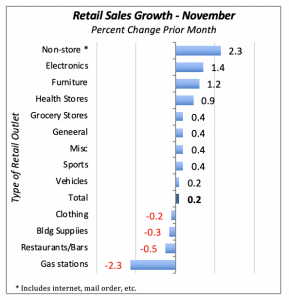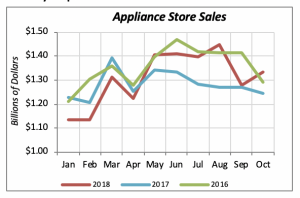
Retail Sales Rise Modestly
Total retail sales increased by a very modest 0.2% to nearly $489 billion last month, which doesn’t seem like a lot, although year-to-date through November, they are 5.3% higher than the comparable period last year, which is healthy growth.
As usual, there were large differences in growth depending on the category. Electronicsand sales at Non-Storeretailers (like the internet or catalogue houses) lead with the fastest growth. Electronics represent less than 2% of total sales, but non-stores account for just under 12% of November’s sales; this means $1 of every $8 is captured by this channel.

Building Materials Sales Dip
In contrast to most other categories, sales of building materials fell by 0.3% to $33.3 billion. This decline, however, follows four months of steady increases.

At the same time, sales at appliance stores rose 7.1% in October to $1.34 billion (note that data for appliance store sales is always one month behind that of other types of products). This is a welcome increase following the modest gain reported in September, with sales less than 1% above the prior year. Sales have exceeded last year’s sales for every month since May.

This improvement may imply that appliance stores could be regaining the market share losses they suffered in 2016 and 2017 to outlets such as home-improvement stores and online sellers such as Amazon and Best Buy.
The chart below compares current year’s sales, by month, to 2016 and 2017 volumes. Clearly, 2017 sales (blue line) lagged behind 2016 (green line) in almost every month. But since May of this year, as stated above, sales are higher than last year’s and are nearly equal to 2016’s.

Consumers Remain Optimistic
Despite the wide fluctuations in the stock market, consumers remain upbeat about the economy and their financial situation, although their expectations for the future have moderated somewhat.
The table below displays the latest statistics from the University of Michigan’s survey.

It remains to be seen whether the drop in expectations reverses itself, or turns out to be a harbinger of rougher times ahead.
Mortgage Rates Fall Again
Interest rates fell further last week, and so did mortgage rates, which impact our businesses more directly. The 30-year fixed mortgage rate, for instance, fell by 12 basis points from the prior week to 4.63%. This is approximately the level they were three months ago.

Since the recent peak of 4.94%, reached just a month ago, mortgage rates have fallen by nearly a third of a basis point (that is, 0.33%), to a level that is perhaps more favorable toward home building and home sales — even though weak demand for housing could be one of the forces driving mortgage rates down.
Manuel Gutierrez, Consulting Economist to NKBA
Explanation of NKBA’s Economic Indicators Dashboard
The dashboard displays the latest value of each economic indicator with a colored triangle that highlights visually the recent trend for each of the drivers. “Green” is a positive signal, indicating that the latest value is improving; “Yellow,” as it’s commonly understood, denotes caution because the variable may be changing direction; “Red” indicates that the variable in question is declining, both in its current value and in relation to the recent past.
Note that all the data, except for “mortgage rate” and “appliance-store sales” are seasonally adjusted and are represented at annual rates.
Remodeling Expenditures. This is the amount of money spent on home improvement projects during the month in question. It covers all work done for privately owned homes (excludes rentals, etc.). The data are in billions of dollars and are issued monthly by the U.S. Department of Commerce.
Single-Family Starts. This is the number of single-family houses for which construction was started in the given month. The data are in thousands of houses and are issued monthly by the U.S. Department of Commerce.
Existing-Home Sales. These data are issued monthly by the National Association of Realtors and capture the number of existing homes that were sold in the previous month.
High-End Home Sales. This series are sales of new homes priced at $500,000 and higher. The data are released quarterly by the U.S. Department of Commerce and are not seasonally adjusted. Thus, a valid comparison is made to the same quarter of prior year.
Mortgage Rate. We have chosen the rate on 30-year conventional loans that is issued by the Federal Home Loan Mortgage Corporation (known popularly as Freddie Mac.) Although there are a large number of mortgage instruments available to consumers, this one is still the most commonly used.
Employees in Residential Remodeling. This indicator denotes the number of individuals employed in construction firms that do mostly residential remodeling work.
Building-Materials Sales. These data, released monthly by the Department of Commerce, capture total sales of building materials, regardless of whether consumers or contractors purchased them. However, we should caution that the data also includes sales to projects other than residential houses.
Appliance-Store Sales.This driver captures the monthly sales of stores that sell mostly household appliances; the data are stated at an annual rate. We should not confuse this driver with total appliance sales, since they are sold by other types of stores such as home centers.
We hope you find this dashboard useful as a general guide to the state of our industry. Please contact us if you would like to see further detail.








